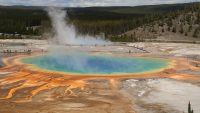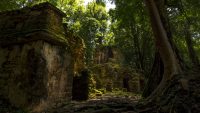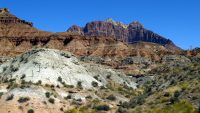The Yellowstone Caldera, often referred to simply as the Yellowstone Supervolcano, is a colossal volcanic caldera located predominantly in Yellowstone National Park in the United States. It represents one of the largest active volcanic systems on Earth, covering an area of about 30 miles by 45 miles (48 km by 72 km). The caldera was formed during massive volcanic eruptions, with the most recent occurring approximately 640,000 years ago. The Yellowstone Caldera is an integral part of the vast Yellowstone Hotspot, a geological phenomenon caused by the North American tectonic plate drifting over a mantle plume.
One of the distinctive features of the Yellowstone Caldera is its geothermal activity, evidenced by the numerous geysers, hot springs, and fumaroles found within Yellowstone National Park. Notable geothermal attractions such as Old Faithful, Grand Prismatic Spring, and Mammoth Hot Springs are manifestations of the immense heat generated beneath the Earth’s surface. The thermal activity is a result of the magma chamber that lies beneath the caldera, providing a fascinating glimpse into the powerful geological forces at play.
Despite its ominous-sounding moniker as a supervolcano, the Yellowstone Caldera is not currently showing signs of imminent eruption. The Yellowstone Volcano Observatory closely monitors the region for any signs of volcanic activity, employing various techniques such as seismic monitoring and gas emission measurements. Understanding the dynamics of the Yellowstone Caldera is crucial for assessing potential hazards and mitigating risks associated with future volcanic events in this geologically dynamic area.

What about Yellowstone Caldera interesting facts? Let’s take a look at these 10 interesting facts about Yellowstone Caldera.
- Supervolcano Status: The Yellowstone Caldera is often referred to as a supervolcano due to its immense size and potential for catastrophic eruptions. It is one of the largest volcanic systems on Earth.
- Magma Chamber Size: Beneath the Yellowstone Caldera lies a massive magma chamber, estimated to be about 30 miles (48 km) wide. The presence of such a substantial magma reservoir contributes to the supervolcano’s classification.
- Recent Eruption: The most recent eruption of the Yellowstone Caldera occurred approximately 640,000 years ago. This event, known as the Lava Creek eruption, deposited volcanic ash across much of North America.
- Geothermal Features: Yellowstone National Park is renowned for its geothermal features, including the iconic Old Faithful geyser. These features are a result of the intense heat generated by the magma chamber beneath the caldera.
- Hotspot Origin: The Yellowstone Hotspot is believed to be caused by a mantle plume—a column of hot and buoyant mantle rock rising from deep within the Earth. The North American tectonic plate drifting over this hotspot has led to the formation of the Yellowstone Caldera.
- Largest Active Hydrothermal System: Yellowstone’s hydrothermal system is the largest active system on the planet. It consists of over 10,000 geysers, hot springs, and fumaroles, showcasing the dynamic geological processes occurring beneath the surface.
- Supereruption Threat: While the chances of a supereruption at Yellowstone in the near future are considered extremely low, the potential consequences of such an event would be catastrophic, affecting global climate and causing widespread environmental impacts.
- Yellowstone Volcano Observatory: The Yellowstone Volcano Observatory, established in 2001, is a collaborative effort between the United States Geological Survey (USGS), the University of Utah, and the National Park Service. It monitors and studies the geologic and hydrothermal processes in the region.
- Caldera Collapse: The Yellowstone Caldera was formed through a series of explosive volcanic events, culminating in the collapse of the magma chamber and the formation of a vast caldera. The caldera’s dimensions are approximately 30 miles by 45 miles (48 km by 72 km).
- Ongoing Geological Activity: Yellowstone experiences ongoing geological activity, including ground uplift and subsidence. Monitoring techniques, such as GPS measurements and seismic studies, help scientists track changes in the region and assess potential volcanic hazards.
The Yellowstone Caldera, a geological marvel of colossal proportions, stands as a testament to the Earth’s dynamic and volatile nature. Its status as a supervolcano, marked by a vast magma chamber and a history of cataclysmic eruptions, evokes both fascination and a sobering awareness of potential hazards. The geothermal wonders of Yellowstone National Park, from the iconic Old Faithful to the expansive hydrothermal system, provide a captivating glimpse into the forces shaping our planet.
Ongoing scientific monitoring and research, spearheaded by institutions like the Yellowstone Volcano Observatory, contribute to our understanding of this unique geological phenomenon. While the prospect of a supereruption remains a remote possibility, the Yellowstone Caldera serves as a reminder of the intricate interplay between geological processes and the ever-changing landscape of our world.



